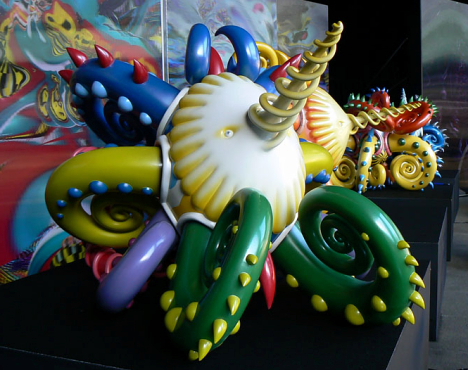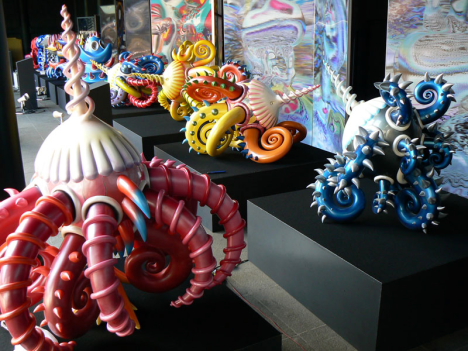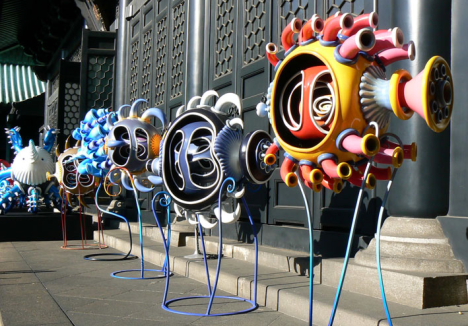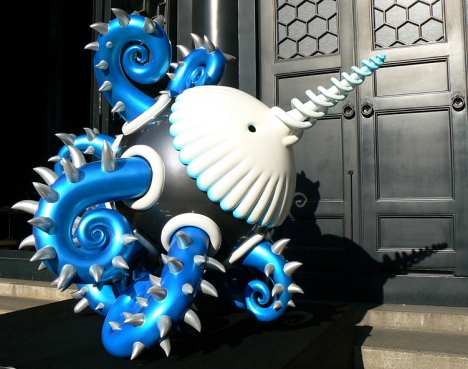
A University of Tokyo research team led by professor/computer graphic artist Yoichiro Kawaguchi is developing robots designed to imitate primitive life forms. Mockups have been put on display at a Confucian temple in Tokyo, and working versions of the robots are scheduled for completion in two years.
According to the researchers, these robots are being developed as a way to explore artificial life and gain insights into how living things survive in a world governed by the law of the jungle.

Kawaguchi and his team are developing a basic reflex system for the primitive artificial life forms, as well as a visual processing system equipped with eyes that recognize and instinctively track certain objects.
In addition, the researchers are working to create powerful biomimetic actuators for locomotion. As part of their research, Kawaguchi and his team have conducted computer simulations to investigate the use of neural oscillators in a locomotion system that imitates the way centipedes crawl. They are also working on simple, mechanical tentacles that extend and contract to move the robot in a specified direction. If all goes according to schedule, they will have a fully functional robot in two years.

With a more thorough understanding of how primitive life forms survive, the researchers believe they can provide robots with a better ability to move, hunt, sense danger, and escape. They suggest that strong survival and hunting skills can be put to use in applications ranging from security guard dog robots to swarm robots tasked with exploring the surface of an alien planet.

Kawaguchi, a professor at the University of Tokyo Graduate School of Interdisciplinary Information Studies, has become known for creating artistic computer graphics programs that exhibit "lifelike" behavior such as self-organization and self-propagation. The robot mockups, which are three-dimensional models of his previous computer graphics work, will remain on display at Yushima Seid? temple until February 8.
[Source: Robot Watch]
UPDATE: More photos HERE.

Timothy
Those mockups are pretty crazy looking. They seem more like a work of art than mockups.
[]Mac
What qualifies a computer graphic artist to lead such an ambitious robotics program? "I draw robots! Build them!"
Somebody at PT make a note to check back in two years and see if they have any sort of robot at all, and whether it bears even a remote resemblance to these cartoon fantasies...
[]Use
This is type of set up you'd read in a post apocalyptic science fiction novel. Programmed with survival instincts and unleashed on the world. A bit terrifying.
[]mo
reminds me of murakami. i'd like to have one...
[]Cam
Mac - chill the hell out. On behalf of humanity, I apologize for the fact that nobody asked you to design these robots. Now go back to perfecting your designs for Transformers 3: The Movie Nobody Wanted.
[]Vanessa
I commented in the subsequent photo post first, but I'll repeat it here:
These are gorgeous, but to my mind Yamaguchi owes Jim Woodring some money.
[]Jason
Sorry, but I don't see the connection between the two artist. Colorful and animated but thats all
[]Mac
Cam - the point is, they aren't even remotely realistic as designs for robots that can be made to do anything useful within a 24 month window. They're plastic sculpture. They'd be very interesting as a pure design exercise (Pink Tentacle is certainly no stranger to that), but to pretend these "designs" will lead to functional robots within just two years is absurd.
[]Reno Graphic Designer
The art is awesome...good graphic design, but I think that they could've been made a little more 'primitavely' Primitave life to me means very simple design.
[]rebeccazg
Matrix, anyone...?
I dont see why they could not be developed. If done so for underwater exploration. Honda have built some amazing working robots, that can walk up stairs as well as over uneven ground. I would have thought that the balance required for that far exceeds that needed for moving through water. At least, if that is the intent.
I think now they have enough knowledge to adapt the working models they have already and apply them to this project. Two years is not unthinkable, if you consider how much research and developement they already have to draw on. Which is scary in itself...
[]Armando Cabba
The idea is crazy. The robots themselves look like art work. Good job Japan in making my nightmares a reality.
[]